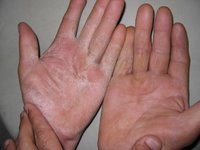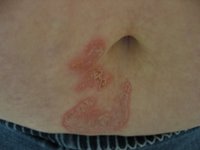Man with hand discoloration

33y, African-American man, working as a manager at Under-Armor, with h/o HTN, relatively well controlled on Labetalol, presents with the depigmentation on his hands. He has had this problems for a few years and has spread progressively.
Exam shows depigmented symmetrical macules on the extensor surface of his hands involving IP and MCP joints.
Which of the following statements is true?
1. The disease presents in the second-third decade of life with a 10-20% likelihood of spontaneous repigmentation- ANSWER.
2. It is likely that the patient has a genetic disorder with defective migration of melanocytes. He is likely to have a white forelock.
3. Antibodies to DNA topoisomerase II appear to be very prevalent in this disease.
4. The patient has lichen sclerosus
5. He could have had this secondary to exposure to certain chemicals at his job.




